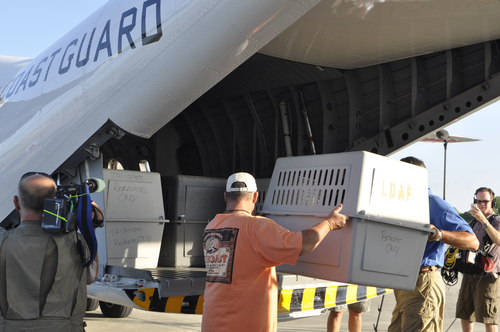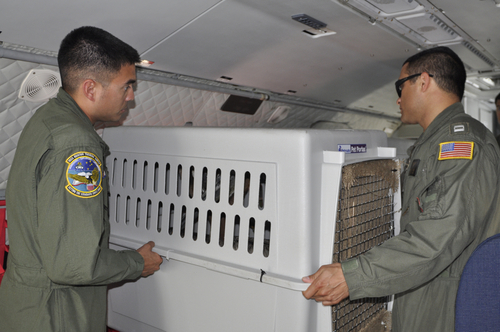 |
| Photo by U.S. Coast Guard video by Petty Officer Second Class Gina Ruoti |
Rescued Pelicans Fly with the Coast Guard
A personal account by U.S. Coast Guard Petty Officer Second Class Gina Ruoti
I never would have imagined I would fly aboard an aircraft with 40 Brown Pelicans to Aransas, Texas. But I’ve come to expect the unexpected when I wear the Coast Guard uniform. And I’m grateful for the chance to serve in this disaster any way I can.
Recently, teams of federal and state fish and wildlife agencies rescued approximately 880 birds from the Deepwater Horizon oil spill in the Gulf of Mexico. A Coast Guard C-144 Ocean Sentry transported 40 of those birds to Aransas, Texas to be released. I recorded our journey, June 20, 2010. Please check out the video here.
Accompanying the precious cargo, Dr. Dan Mulcahy, wildlife veterinarian, Dr. Margret Wild, National Park Service veterinarian, and Thomas Melius, U.S. Fish & Wildlife. After the flight, they released the birds back to the wild at the Aransas National Wildlife Refuge. I’m told by the U.S. Fish and Wildlife Service that the marsh and wetlands in Texas are similar to their native habitat, but far enough away from the oil to reduce the likelihood of them returning. All of these birds are banded for tracking.
The Coast Guard aircrew: Lt. Rene Baez, Lt. Brad Winans, AMT2 Stephen Perusin, and AMT3 Daniel Weaver, renamed their aircraft Pelican One for this flight.
I’m honored to have the opportunity to document the transport of these amazing creatures and to witness the collaborative interagency teamwork involved with their care.
 |
| Photo by U.S. Coast Guard video by Petty Officer Second Class Gina Ruoti |
I asked Dr. Mulcahy a couple of questions:
Q: How long is the rehabilitation process?
A: After the birds are washed, the procedure also removes the natural oil the birds use for waterproofing. So after cleaning, they can’t be released immediately. They are held anywhere from 8-10 days in order to get their waterproofing back. Before we release them, they are given a physical examination by wildlife veterinarians. Testing their waterproofing is a part of that examination. The birds released today were caught anywhere between 1 to 2 weeks ago.
Q: What does today (June 20) mean to you?
A: This is a great day for oiled pelicans. We have about 40 birds that have come through the process of being cleaned and stabilized. Now they are at their new home in Aransas National Wildlife Refuge thanks to the Coast Guard. We’re about to take them down to the beach for release. We are very pleased with the results of that.
NOTE: The latest statistics from the U.S. Fish and Wildlife can be found here. Hundreds of birds and wildlife have been treated and released since June 20.
| Share |
